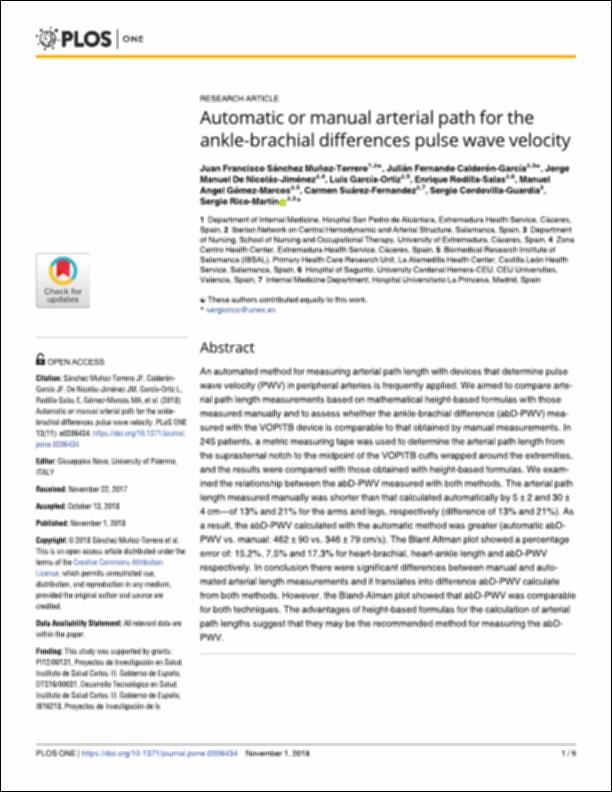Please use this identifier to cite or link to this item:
http://hdl.handle.net/10637/10523Automatic or manual arterial path for the ankle-brachial differences pulse wave velocity
| Title: | Automatic or manual arterial path for the ankle-brachial differences pulse wave velocity |
| Authors : | Sánchez Muñoz-Torrero, Juan Francisco Calderón García, Julián Fernando Nicolás Jiménez, Jorge Manuel de García Ortiz, Luis Rodilla Sala, Enrique Gómez Marcos, Manuel Ángel Suárez Fernández, Carmen Cordovilla Guardia, Sergio Rico Martín, Sergio |
| Keywords: | Ritmo cardíaco - Medición - Modelos matemáticos.; Pulse - Mensuration - Mathematical models.; Cardiovascular system - Diseases - Risk factors.; Pulso - Medición - Modelos matemáticos.; Presión sanguínea - Medición - Modelos matemáticos.; Hipertensión.; Hypertension.; Enfermedades cardiovasculares - Factores de riesgo.; Blood pressure - Measurement - Mathematical models. |
| Publisher: | PLOS. |
| Citation: | Munoz-Torrero, JFS., Calderon-Garcia, JF., Nicolas-Jimenez, JM. de., Garcia-Ortiz, L., Rodilla-Salas, E., Gomez-Marcos, MA. et al. (2018). Automatic or manual arterial path for the ankle-brachial differences pulse wave velocity. Plos One, vol. 13, n. 11, art. e0206434. DOI: https://doi.org/10.1371/journal.pone.0206434 |
| Abstract: | An automated method for measuring arterial path length with devices that determine pulse wave velocity (PWV) in peripheral arteries is frequently applied. We aimed to compare arterial path length measurements based on mathematical height-based formulas with those measured manually and to assess whether the ankle-brachial difference (abD-PWV) measured with the VOPITB device is comparable to that obtained by manual measurements. In 245 patients, a metric measuring tape was used to determine the arterial path length from the suprasternal notch to the midpoint of the VOPITB cuffs wrapped around the extremities, and the results were compared with those obtained with height-based formulas. We examined the relationship between the abD-PWV measured with both methods. The arterial path length measured manually was shorter than that calculated automatically by 5 ± 2 and 30 ± 4 cm—of 13% and 21% for the arms and legs, respectively (difference of 13% and 21%). As a result, the abD-PWV calculated with the automatic method was greater (automatic abDPWV vs. manual: 462 ± 90 vs. 346 ± 79 cm/s). The Blant Altman plot showed a percentage error of: 15,2%, 7,5% and 17,3% for heart-brachial, heart-ankle length and abD-PWV respectively. In conclusion there were significant differences between manual and automated arterial length measurements and it translates into difference abD-PWV calculate from both methods. However, the Bland-Alman plot showed that abD-PWV was comparable for both techniques. The advantages of height-based formulas for the calculation of arterial path lengths suggest that they may be the recommended method for measuring the abDPWV. |
| Description: | Este artículo se encuentra disponible en la página web de la revista en la siguiente URL: https://journals.plos.org/plosone/article?id=10.1371/journal.pone.0206434 |
| URI: | http://hdl.handle.net/10637/10523 |
| Rights : | http://creativecommons.org/licenses/by/4.0/deed.es |
| ISSN: | 1932-6203. |
| Issue Date: | 1-Nov-2018 |
| Center : | Universidad Cardenal Herrera-CEU |
| Appears in Collections: | Dpto. Medicina y Cirugía |
Items in DSpace are protected by copyright, with all rights reserved, unless otherwise indicated.


